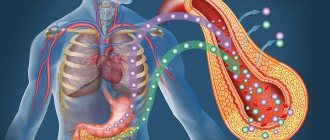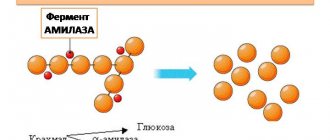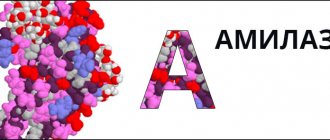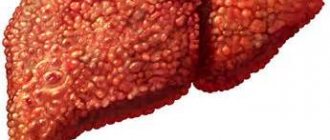Amylase is an enzyme that can break down carbohydrates. The enzyme produced by the pancreas is called pancreatic amylase. A test for its quantity is a study that is widely used in therapeutic practice. The biomaterial for research is venous blood. It must be taken on an empty stomach in the first half of the day. Before the study, you should not eat food, drink coffee or tea. The day before, it is recommended to limit your consumption of fatty and spicy foods.
Taking a blood test for pancreatic amylase is especially important if the patient has abdominal syndrome or severe pain.
The role of amylase in the blood
This is a digestive enzyme that is involved in the breakdown of carbohydrates, starch and glycogen. It is formed in the pancreas and salivary glands. If there are failures in carbohydrate metabolism, its value deviates from acceptable norms.
Functions
By breaking down carbohydrates, this enzyme becomes involved in the digestion process. Its main function is the hydrolysis of starch. Its breakdown occurs in the mouth under the action of saliva. During this period, salivary amylase is active.
Its activity decreases if food is not chewed properly.
Hydrolysis of starch continues in the intestine under the action of alpha-amylase produced by the pancreas.
The digestive enzyme is activated at night when you eat. Therefore, late snacking and poor chewing are harmful to the body. An enzyme excluded from the digestive process provokes the development of pancreatitis and other diseases.
Deviations from the norm
An increase in amylase content can be caused by the following reasons:
- Acute pancreatitis. The enzyme level increases several times, reaching maximum levels within 12 hours after the attack. Then the level begins to gradually decrease.
- Chronic pancreatitis. In this case, the excess is not so significant, but persistent.
- Diabetes. The increase in enzyme levels is insignificant.
- Acute inflammatory diseases of the abdominal organs - appendicitis, peritonitis.

- Neoplasms (cysts, tumors) in the pancreas. Neoplasms compress the organ, causing secondary inflammation, which leads to changes in the production of enzymes.
- Kidney failure.
- The pregnancy is ectopic.
- Mumps is an inflammation of the salivary glands. With this disease, the content of the S-type enzyme increases.
- Poisoning. In case of poisoning, the increase in amylase levels is short-lived.
A reduced level of amylase in biological fluids does not have significant diagnostic value. That is, based on the fact that amylase is low, a diagnosis cannot be made; additional examinations will need to be carried out to identify the causes of this condition.
Most often, the reasons for low content are the following:
- absence of the pancreas if this organ was removed during surgery. In this case, replacement therapy by taking enzymes is necessary;
- necrotic changes in part of the pancreas with complete tissue destruction;
- oncological diseases of the liver, stomach, intestines;
- hepatitis occurring in chronic or acute form;
- cystic fibrosis is a hereditary disease in which metabolic processes are disrupted;
- toxicosis of pregnant women.

Types of amylase
There are two types: pancreatic and diastasis (alpha-amylase). The first is produced in the stomach and intestines, and the second in the salivary glands. More than half of the amylase (about 60%) is of the latter type. The first is part of the pancreatic juice that is transported to the duodenum.
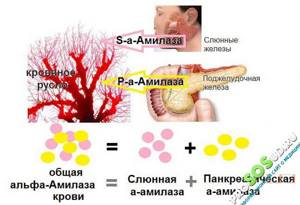
Alpha amylase, produced by the salivary glands and stomach and found in digestive juice, is adapted to the conditions of the human body. This enzyme is excreted by the kidneys during urinary excretion. Therefore, it can also be found in urine.
Prevention

Limiting fast foods and snacks is an important point of prevention
- Moderation in the consumption of fatty, spicy foods, and alcoholic beverages. Compliance with the diet (eat more often but little by little, do not eat at night, maintain the ratio of proteins-fat-carbohydrates and microelements in food, refuse fast food, various hot and sour sauces and industrial seasonings, sweet carbonated drinks, limit the consumption of coffee, strong tea ).
- Periodically undergo examination (for example, medical examination or routine medical examinations at the place of work).
- Do not self-medicate if you periodically experience pain in the upper abdomen or if you suspect diabetes. Be sure to consult a doctor.
- Get into the habit of chewing your food thoroughly. When we swallow food hastily, it does not have time to combine with saliva, which means it enters the stomach without beginning to interact with amylase.
Indicator norm
It is important for health to maintain an average amount of this enzyme. The norm for women and men ranges from 28 to 100 units per liter. For people over 70 years of age, values up to 160 are acceptable.
The average amount of alpha-amylase ranges from 25 to 125 units/liter. The normal level of pancreatic enzymes is up to 50 units/l, but the lower the better.
Going to zero speed tells you that the RV has the enzyme under control. However, its sharp decrease causes a pathological process.
During a comprehensive examination, the enzyme content in the urine is determined, the norm of which is from 1 to 17 units / liter. This figure may fluctuate throughout the day.
Decoding the results
Competent interpretation of the study results can only be performed by a doctor; self-medication is unacceptable. Normally, the enzyme concentration should not exceed 53 U/l. If the indicators deviate from the norm, the doctor prescribes an additional examination in order to make an accurate diagnosis and choose the most effective treatment method.
Important Notes:
- determination of the enzyme level is not included in the CBC;
- while taking a number of medications, it is possible to obtain false results;
- the test result is influenced by high cholesterol levels;
- In patients with chronic renal failure, false-positive results may be obtained.
Causes of increased and decreased alpha-amylase
An increase in indicators may be caused by the following reasons:
- pancreatic injury;
- inflammatory process;
- malignant degeneration of the pancreas;
- peritonitis;
- perforated ulcer;
- intestinal obstruction;
- pancreatitis;
- appendicitis;
- aneurysm rupture.
To determine the exact cause of the increase in the amount of enzyme and prescribe treatment (if necessary), additional examination is carried out. A decrease in indicators can be observed with cystic fibrosis.
When interpreting the results, not only the level of pancreatic amylase is taken into account, but also the total amount of enzyme. If general indicators are increased and pancreatic enzyme activity is decreased, this indicates that pancreatic pathologies are most likely absent. In such cases, an examination is carried out aimed at establishing an accurate diagnosis.
The most common cause of increased levels is pancreatitis.
Usually, enzyme activity increases significantly, but in some cases it may remain within normal limits. It must be taken into account that the results of this test cannot determine the degree of damage to the pancreas. When the disease becomes chronic, the indicators first increase and then can gradually decrease as the pathological process progresses.
What are the indications for checking amylase levels?
Tests are carried out to monitor the functioning of prostate adenoma and salivary glands, as well as to identify or exclude pathologies:
- if you suspect diabetes mellitus;
- in case of “acute abdomen”;
- with a diagnosis of “chronic pancreatitis”, other problems with poisoning;
- suspicion of ovarian abnormalities;
- In the process of inflammation of the parotid gland (“mumps”);
- When examining the salivary glands;
- Viral infections.
These tests are also indicated in cases of decreased vascular wall thickness.
How to Diagnose Low Amylase Levels

Nausea and bitterness in the mouth are nonspecific signs of low amylase.
If pancreatic disease is suspected, blood is taken for biochemical analysis. Among other indicators, amylase is also studied. Blood is taken on an empty stomach. The day before the test, you need to exclude fatty and spicy foods, alcohol, tea and coffee. The analysis is taken on an empty stomach in the morning.
Examine blood serum using biochemical analyzers
What symptoms may be a reason for examination:
- nausea, vomiting, diarrhea;
- pain: in the right hypochondrium or encircling;
- bitterness in the mouth;
- general weakness;
- increased liver size upon palpation or detected by ultrasound;
- decrease or increase in blood sugar.
Analyzes to determine the indicator
Venous blood is collected on an empty stomach. If tests are scheduled, they should be prepared in advance. You can read more about this below.
Preparation
It is worth limiting yourself and, if possible, excluding drugs that increase indicators (listed below).
In case of urgent indications, blood sampling for analysis is carried out without special preparation.
The quantitative content (titer) of this substance is also determined by urine analysis. Only a qualified doctor can accurately interpret the results and their meaning.
The influence of medications taken on the accuracy of the result
The actual test result may be distorted by the use of medications such as:
- Captopril;
- Ibuprofen;
- Furosemide;
- Corticosteroids;
- painkillers;
- Oral contraceptives.
The pancreatic enzyme indicator may falsely rise after using these drugs. If you cannot stop them, you should wait for the doctor to take them.
What can affect the analysis results

Drinking alcohol on the eve of the test is not recommended
If the situation is critical and the analysis is taken in a hospital, then the numbers obtained in the laboratory are considered true, regardless of what time the blood was donated, how long ago the person ate, etc.
If blood sampling occurs in a more relaxed mode and the result is in doubt, then this may be due to a violation of the recommendations for preparing for the test:
- perhaps the patient was taking some medications that he forgot about or did not want to notify the doctor;
- exercised intensively in the morning, before donating blood;
- maybe there was stress, a nervous breakdown, psycho-emotional instability;
- maybe the patient did not follow the recommended diet or drank alcohol.
In addition to factors depending on the patient, there may be errors made by the staff of the medical institution. For example:
- late delivery to the laboratory;
- delivery at high or low ambient temperatures without a special container.
Reasons for low performance
Low amylase occurs less frequently than high amylase. This may indicate decreased enzymatic activity or destruction of the gastrointestinal tract, severe symptoms of cancer or hepatitis.
Alpha enzyme concentrations may be decreased as a result of prostate surgery. Values may be reduced due to injury.
What does enzyme deficiency mean?
Reduced amylase levels are associated with the destruction of PP tissue and can signal diseases such as:
- pancreatic failure, complete absence of the pancreas;
- toxicity during pregnancy;
- chronic or acute hepatitis;
- Severe liver failure;
- Pancreatectomy;
- Cystic fibrosis (cystic fibrosis in the duodenum).
A low indicator limit is typical for people with high levels of total cholesterol.
A low level of pancreatic amylase in the presence of increased integer amylase activity indicates a low likelihood of prostate injury. In this case, special attention should be paid to the ovaries, skeletal muscles, intestines and the exclusion of accompanying pathologies.
Frequently asked questions about analysis. Part - 8
What is amylase?
Amylases (alpha-amylase) are a group of enzymes that serve to break down complex carbohydrates inside the pancreas, which is an exocrine gland. The enzyme is synthesized by acinar cells and then passes through the pancreatic ducts to reach the digestive tract.
Amylases are also produced by the salivary glands, small intestinal mucosa, ovaries, placenta and liver. Pancreatic and salivary isoenzymes are detected in the blood at high concentrations by examination.
Under normal conditions, amylase is present in small amounts in the blood and urine, however, when the cells of the pancreas have some problem, such as pancreatitis or when the pancreas is blocked by a stone, or in rare cases by a tumor, the enzymes enter the blood circulation more easily, so their concentration increases as in blood and in urine (amylase leaves the body through urine).
Amylase testing is often used by doctors to diagnose pancreatitis. Pancreatic amylase testing (amylase P isoenzyme) is most useful for laboratory diagnosis of acute pancreatitis.
Total serum (blood) is still the most widely used method for diagnosing acute pancreatitis and is accurate to 95% (accuracy of a diagnostic test refers to its ability to provide true values).
What amylase values are considered normal?
Normal amylase values by age:
- 0-30 days (newborn): 0-6 units/l
- 31-182 days: 1-17 units/l
- 183-365 days: 6-44 units/l
- 1-3 years: 8-79 units/l
- 4-17 years: 21-110 units/l
- after 18 years (adults): 26-102 units/l
Pancreatic amylase by age:
- 0-24 months: 0-20 units/l
- 2-18 years: 9-35 units/l
- after 18 years: 11-54 units/l
What are the reasons for increased amylase?
Reasons that cause an increase in the amount of alpha-amylase in the blood (increased blood amylase is considered to be numbers above 105 units/l for alpha-amylase and above 50 units/l for pancreatic amylase):
- Acute or chronic pancreatitis . With inflammation of the pancreas, the secretion of amylase by cells increases several times
- Cyst, tumor or stone in the lumen of the pancreas . A change in the structure of the gland causes compression of the glandular tissue and its secondary inflammation, which increases the secretion of amylase (amylase level reaches 150-200 units/l).
- Parotitis . Inflammation of the salivary glands also causes increased secretion of amylase.
- Peritonitis . With peritonitis, all organs of the abdominal cavity, including the pancreas, are subject to irritation and inflammatory changes. Such changes increase the activity of pancreatic cells, which leads to increased amylase levels in the blood test.
- Diabetes . Diabetes mellitus causes systemic metabolic disorders, including carbohydrate metabolism. Thus, not all amylase produced by the body will be rationally spent on converting starch into oligosaccharides, which will lead to an increase in its amount in the blood.
- Kidney failure . Since amylase is excreted from the body through the kidneys, insufficient kidney function will cause a delay and increase in the amount of enzyme in the blood. The reasons for the decrease in the amount of amylase in the blood are considered to be figures less than 100 U/L for alpha-amylase.
- Hepatitis in acute or chronic form . With hepatitis, carbohydrate metabolism is disrupted, which entails an increased load on the body's enzymatic systems, including amylase. For a certain time, the pancreas produces a sufficient amount of the enzyme, but subsequently begins to slow down the process of amylase synthesis, which will be reflected in its low amount in a blood test.
- Pancreatic tumors . Some tumors cause degeneration of pancreatic tissue, which makes amylase secretion impossible.
- Also, as a result of injuries, falls from a height and poisoning, amylase secretion may be impaired, either to a greater or lesser extent.
In our clinic, you can consult a gastroenterologist and undergo all the necessary tests, including ultrasound of the abdominal organs.
What to do if amylase is low?
Low levels of the enzyme are much less common than high levels. Such changes in the analysis are typical for pancreatic failure, cystic fibrosis, severe liver damage (liver failure), pancreaectomy (removal of the pancreas).
Increased blood cholesterol levels can lead to low pancreatic amylase levels. In children of the first year of life, the level of the enzyme is much lower than in adults. This is due to the fact that the food they receive is devoid of sufficient amounts of complex carbohydrates.
What is dangerous about changes in amylase levels?
In itself, the condition when amylase is elevated does not have clinical consequences for the body, however, it is an important marker of pancreatic damage. If an increase in the enzyme index is detected, the analysis is usually monitored within 24 hours, which makes it possible to assess the dynamics of the pathological process.
A decrease in the level of the enzyme against the background of deterioration in the patient’s well-being indicates severe destruction of pancreatic tissue.
You should pay close attention to the situation. ‹ Previous page | Next page >
Level normalization
After studying, determining the cause and provoking factor, adequate therapy is prescribed to normalize enzyme values. An important step is to treat the disease that led to the deviation from the norm.
Therapy depends on the stage of the pathology. In addition to treatment, a balanced diet is recommended, which includes:
- Product exclusion: fried, smoked, fatty, spicy, baked;
- No alcohol consumption;
- Preferential use of oven-baked, steamed foods;
- Fractional meals at least 4-5 times a day;
- Eliminate hunger.
During treatment, if possible, give up bad habits. To increase the effectiveness of therapy, it is necessary to practice regular walks, regular sleep and rest, and reduce activity, both physical and mental.
Medicines prescribed by a specialist doctor:
